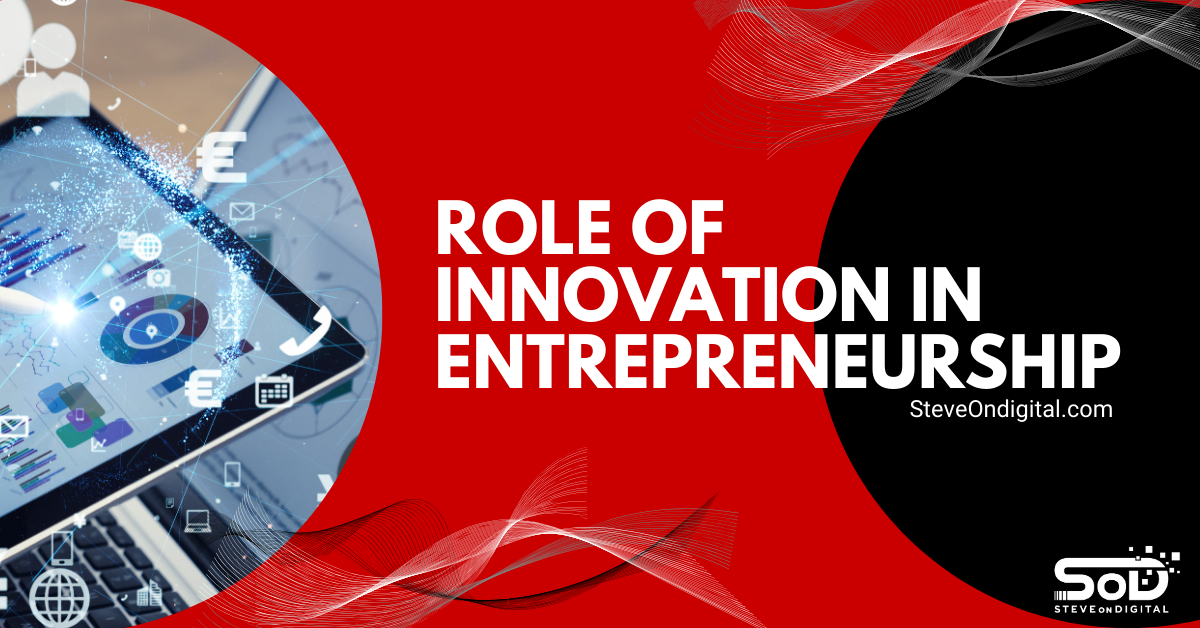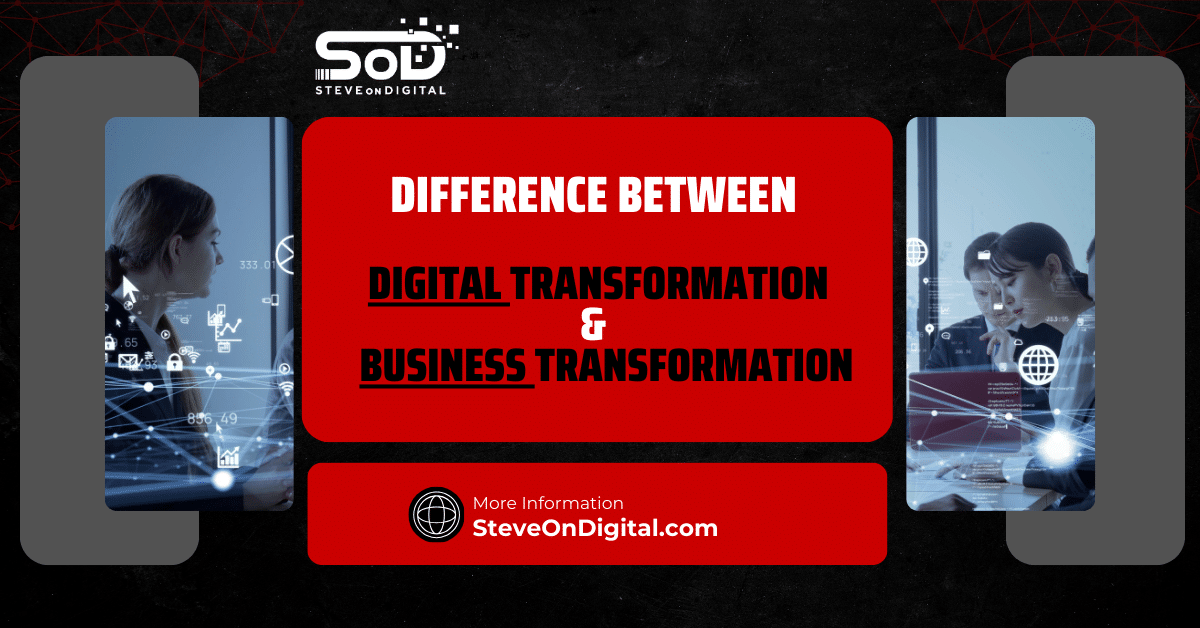In the ever-evolving world of entrepreneurship, innovation stands as a beacon of progress, guiding businesses towards success and sustainability.
As Steve Johnston, a seasoned expert in digital transformation for SMEs, I’ve witnessed firsthand the transformative power of innovation in reshaping industries and propelling businesses into new realms of possibilities.
This blog post delves into the essence of innovation in entrepreneurship, highlighting its significance for entrepreneurs and businesses striving to make their mark in a competitive landscape.
Innovation in entrepreneurship isn’t just about introducing new products or services; it’s a comprehensive approach that encompasses reimagining business models, refining processes, and adopting emerging technologies to meet and exceed market demands.
It’s the lifeblood of entrepreneurial ventures, driving economic growth, fostering competitive advantage, and enhancing customer loyalty through creative development and innovative solutions.
The significance of innovation extends beyond mere survival in the business world.
It represents the key to unlocking new markets, achieving long-term success, and creating a legacy that transcends the boundaries of existing markets.
For entrepreneurs, innovation is not an option but a necessity, a crucial driver of entrepreneurial success that demands a continuous commitment to creative thinking, risk-taking, and strategic foresight.
Section 1: Understanding Innovation In Entrepreneurship
Definition And Dimensions Of Innovation
Innovation, in its broadest sense, refers to the process of introducing something new or improving something existing, whether it’s a product, service, or a way of doing business.
However, it encompasses much more than mere novelty; it involves a series of systematic, strategic steps designed to bring about significant, positive change.
Innovation in entrepreneurship is characterized by its ability to challenge the status quo, offering innovative solutions that meet emerging trends and market demands.
Types Of Innovation: Disruptive, Incremental, Radical, And Architectural
- Disruptive Innovation: This form of innovation upends established markets by introducing new ideas and technologies that create new, unexpected value propositions. It’s about turning conventional wisdom on its head and reshaping market dynamics.
- Incremental Innovation: Focused on making small, yet impactful changes to existing products or services, incremental innovation seeks to enhance efficiency, productivity, and customer experiences. It’s a key driver in fostering continuous improvement and staying ahead of the competitive landscape.
- Radical Innovation: Radical innovation introduces groundbreaking ideas or technologies that fundamentally alter how businesses operate, creating entirely new markets or revamping existing ones. It’s often what propels businesses to the forefront of their industry.
- Architectural Innovation: This type reconfigures existing product technologies into new applications, tapping into different markets or user needs. It combines the novel and the known in innovative ways to encourage innovation and foster growth.
Distinction Between Innovation And Invention
While innovation and invention are closely linked, they are not interchangeable.
Invention is the creation of a new idea or concept, the spark that ignites the potential for change.
Innovation, on the other hand, is the practical application of these inventions or new ideas, transforming them into tangible, marketable solutions that address specific customer needs and business strategies.
It’s about taking the leap from theoretical to practical, from idea to impact.
Section 2: The Catalysts Of Entrepreneurial Innovation
In my journey as the founder of SteveOnDigital, I’ve seen firsthand how innovative ideas act as the backbone of industry transformation.
Innovation isn’t just about newness; it’s about making changes that add value, fundamentally altering how we perceive and interact with the world around us.
Let’s dive into the catalysts that drive entrepreneurial innovation and, subsequently, reshape entire industries.
Role Of Innovative Ideas In Shaping Industries
Innovative ideas have the power to disrupt traditional business models, paving the way for new markets and opportunities.
Take, for example, how disruptive innovation has led to the rise of the sharing economy.
Platforms like Airbnb and Uber didn’t just offer new services; they changed how we think about accommodation and transportation, challenging established sectors to adapt or face obsolescence.
This kind of innovation underscores the importance of entrepreneurial ventures in not just participating in the market but actively reshaping it.
Exploring Innovative Solutions And Their Impact On Business Success
The implementation of innovative solutions is critical for achieving business success.
These solutions often stem from identifying market gaps and leveraging emerging technologies to address them.
As a digital transformation specialist, I’ve helped SMEs introduce innovative products that significantly enhance their competitive advantage.
Whether it’s through innovative projects that streamline operations or innovative strategies that redefine customer engagement, the result is a marked improvement in economic growth and customer loyalty.
Importance Of Adopting New Business Models In Response To Market Trends
Staying relevant in today’s fast-paced world means being agile and responsive to market trends.
New business models are not just about innovation for its own sake but about survival and sustainability.
For instance, the subscription model, popularized by companies like Netflix, has now been adopted across industries from software to food delivery.
This shift was not just about offering something new but about aligning business operations with changing consumer preferences and market dynamics.
Section 3: Innovation’s Influence On Market Dynamics
Innovation doesn’t just change businesses; it changes the market itself.
Here’s how entrepreneurship innovation plays a crucial role in this dynamic.
Analyzing Entrepreneurship Innovation In Adapting To Market Gaps
Market gaps offer a clear signal for where innovation can take root.
My experience in digital transformation has shown me that businesses that can identify and fill these gaps not only secure their place in the market but often redefine it.
Entrepreneurial innovation involves using innovative ideas to address unmet needs, leading to the development of innovative products and services that can capture new markets.
How Innovative Culture Fosters Competitive Advantage
An innovative culture is foundational to maintaining a competitive edge.
It encourages continuous creative thinking and risk-taking, essential for business growth and long-term success.
In my role, fostering a culture where innovative efforts are celebrated and where failure is seen as a step towards learning has been pivotal in nurturing successful businesses.
This culture is what enables companies to stay ahead of the competitive landscape, turning challenges into opportunities for innovation.
The Significance Of Creative Development In Innovation
Creative development in innovation isn’t just about creating new products; it’s about rethinking existing processes and finding ways to enhance customer experiences.
This process is integral to innovative businesses, as it leads to enhanced customer experiences and builds customer loyalty.
By integrating customer feedback into the innovation process, businesses can ensure their innovations are not only novel but also deeply relevant and valuable to their target audience.
Section 4: From Ideas To Implementation
The journey from innovative ideas to their successful implementation is both exhilarating and daunting.

As the founder of SteveOnDigital, I’ve navigated this path multiple times, transforming visions into tangible outcomes that drive business growth and entrepreneurial success.
Process Of Transforming Innovative Ideas Into Successful Ventures
Transforming an innovative idea into a successful venture involves several key stages:
- Idea Validation: Confirming that the idea addresses a real market gap or customer need.
- Market Research: Understanding the target audience, competitive landscape, and market trends.
- Prototype Development: Creating a working model to demonstrate the feasibility and function of the idea.
- Feedback Loop: Integrating customer feedback to refine and enhance the product or service.
- Business Model Formulation: Designing a business strategy that outlines how the venture will create value and generate revenue.
- Launch and Scale: Introducing the product to the market and scaling operations to meet demand.
Throughout these stages, maintaining an innovative culture within the organization is crucial.
It encourages creative thinking, risk-taking, and continuous improvement, ensuring the venture remains dynamic and adaptable.
Innovative Projects And Their Journey From Conception To Market
Reflecting on my own experiences, each innovative project is a unique journey.
For instance, launching an online platform that leverages emerging technologies to connect SMEs with digital transformation resources was a venture that transitioned from a mere concept to a successful business.
This journey involved rigorous market analysis, iterative development, and continuous adaptation to emerging trends and customer feedback, embodying the essence of entrepreneurship innovation.
Strategies To Encourage Innovation Within Organizations
Fostering an environment that nurtures innovation is key to sustainable business success.
Strategies that have proven effective include:
- Establishing a clear vision that champions innovation.
- Creating a safe space for creative ideas and risk-taking.
- Implementing an innovation process that encourages entrepreneurial thinking.
- Recognizing and rewarding innovative efforts and achievements.
- Promoting collaboration across teams to merge diverse perspectives and skills.
Section 5: Technology And Innovation
The intersection of technology and innovation in entrepreneurship cannot be overstated.
In the digital age, emerging technologies play a critical role in enabling businesses to pioneer new markets, enhance customer experiences, and achieve competitive advantage.
Exploring Emerging Technologies And Their Role In Entrepreneurial Ventures
Emerging technologies, such as AI, blockchain, and IoT, offer unprecedented opportunities for entrepreneurial innovation.
These technologies can drive productivity innovation, create innovative products, and open up new business models.
For example, AI has revolutionized customer service through chatbots, personalized recommendations, and predictive analytics, enhancing customer loyalty and fostering business growth.
Case Studies Of Innovative Businesses Leveraging New Technologies For Growth
One illustrative example is a startup I advised, which developed an AI-powered tool to optimize online advertising campaigns, significantly reducing costs and improving ROI for SMEs.
This venture not only showcased the unique selling point of using AI for marketing efficiency but also demonstrated the broader role of innovation in entrepreneurship—transforming a new technology into a competitive tool for businesses.
Another case involves a company that implemented IoT devices to monitor environmental conditions in agriculture, leading to improved crop yields and resource management.
This project underscored the crucial role of technology in addressing environmental challenges and enhancing economic growth.
Section 6: Innovation And Competitive Strategy
In the competitive arena of modern entrepreneurship, innovation serves as the linchpin for securing a market advantage and driving business success.
Drawing from my journey with SteveOnDigital, I’ve seen firsthand how innovative strategies not only differentiate your offering but also define your brand in the eyes of your target audience.

Achieving A Competitive Edge Through Innovative Strategies
Innovation is not merely about new products or services; it’s about reimagining how we do business, connect with customers, and deliver value.
For instance, innovative business models like subscription services or freemium models disrupt traditional one-time purchase setups, creating continuous engagement with the customer.
This approach not only enhances customer loyalty but also establishes a competitive advantage by aligning more closely with customer needs and preferences.
Identifying Opportunities For Innovation To Achieve Business Success
Opportunities for innovation often lie in the most unexpected places.
Whether it’s through emerging technologies, market gaps, or customer feedback, being attuned to these signals is crucial.
In my experience, regularly reviewing our business processes and market trends helped us spot inefficiencies or new demands, leading to innovative solutions that drove our business growth.
It’s about looking at the familiar with fresh eyes and asking, “How can we do this better?”
Role Of Innovation In Developing A Unique Selling Point (USP)
Your USP is what sets you apart in a crowded market.
Innovation is key to carving out this niche.
By leveraging innovative ideas and emerging trends, businesses can create a proposition that resonates deeply with their target audience.
In the digital age, a USP could be as simple as an innovative customer service approach using AI chatbots or as complex as a groundbreaking new product that opens up new markets.
Section 7: The Human Element Of Innovation
While technology and strategies are critical, at the heart of innovation lies the human element.
The creativity, resilience, and vision of individuals within an organization fuel the innovation process.
The Importance Of Fostering An Innovative Culture For Long-term Success
An innovative culture is one where new ideas are encouraged, and failure is seen as a stepping stone to learning.
Such a culture promotes creative thinking and risk-taking, essential components for entrepreneurial innovation.
At SteveOnDigital, creating an environment where everyone feels empowered to suggest new ideas has been pivotal to our long-term success.
This culture has not only attracted talented individuals but also fostered a sense of ownership and commitment across the team.
Encouraging Creative Thinking And Risk-Taking Among Team Members
Innovative cultures thrive on diversity of thought and a willingness to experiment.
Encouraging team members to take calculated risks without fear of repercussion promotes a dynamic, agile approach to business challenges.
Techniques like brainstorming sessions, hackathons, or innovation workshops can stimulate creative development and surface innovative ideas that might otherwise remain untapped.
Utilizing Customer Feedback For Continuous Innovation And Improvement
In today’s customer-centric business landscape, customer feedback is invaluable.
It provides direct insights into what works, what doesn’t, and what customers are looking for.
By actively seeking out and incorporating this feedback into the innovation process, businesses can ensure their offerings remain relevant and competitive.
This loop of feedback and improvement is essential for fostering customer loyalty and driving business success.
Section 8: Innovation And Economic Impact
The fabric of our global economy is woven with threads of innovation.
It’s a force that not only drives business success but also propels economic growth and job creation at a macro level.
Reflecting on my experiences with SteveOnDigital, I’ve seen the tangible impact innovative endeavors can have, not just within our organization but across the broader digital landscape.
Innovation’s Role In Driving Economic Growth And Job Creation
Innovation serves as a cornerstone for economic development.
It introduces new products and services that stimulate demand, creates new markets, and encourages competitive dynamics that necessitate job creation.
For instance, the rise of digital platforms and ecommerce has not only revolutionized retail but also created millions of jobs worldwide, from tech developers to digital marketers.
| Innovation Aspect | Economic Impact | Example |
| New Products & Services | Stimulates demand and creates new markets. | Introduction of electric vehicles has created a new automotive market segment. |
| Job Creation | Innovations in various sectors lead to the creation of new job roles. | The tech sector’s expansion has led to a significant increase in jobs for software developers. |
| Competitive Dynamics | Encourages companies to innovate, leading to a more dynamic and competitive market. | Streaming services have revolutionized the entertainment industry, fostering competition. |
| Societal & Environmental Solutions | Addressing environmental and societal issues can lead to sustainable economic growth. | Renewable energy innovations contribute to sustainable development and open up new business avenues. |
The Impact Of Innovative Products On Customer Loyalty And Market Share
Innovative products that meet or exceed customer expectations can significantly enhance customer loyalty and expand market share.
Personal experience has shown that when a business introduces something truly groundbreaking, it doesn’t just attract attention—it fosters a sense of brand loyalty that is hard to shake.
Such products also serve as a testament to a company’s commitment to innovation, often becoming a key differentiator in crowded markets.
Entrepreneurial Innovation As A Key Driver For Societal And Environmental Solutions
Entrepreneurship innovation plays a pivotal role in addressing some of the most pressing societal and environmental challenges.
Whether it’s through sustainable business practices, renewable energy technologies, or social enterprises aiming to solve specific community issues, innovative entrepreneurs are at the forefront of driving positive change.
This not only exemplifies the broader impact of innovation but also highlights the responsibility of entrepreneurs to leverage their capabilities for the greater good.
Section 9: Challenges And Solutions In Pursuing Innovation
While the path of innovation is rewarding, it’s fraught with challenges.

However, understanding these obstacles and leveraging support systems can pave the way for a smoother innovation journey.
Barriers To Innovation In Entrepreneurship And How To Overcome Them
Entrepreneurs often face hurdles such as limited resources, market resistance, regulatory challenges, and difficulty in scaling.
Overcoming these barriers requires a mix of resilience, strategic planning, and leveraging external support.
Networking, partnership, and funding opportunities, such as grants and venture capital, can provide the necessary boost.
Moreover, adopting a lean startup approach—focusing on building minimum viable products and iterating based on feedback—can also help in efficiently navigating through the innovation process.
Role Of Government And Educational Institutions In Supporting Innovation
Governments and educational institutions play a crucial role in nurturing the innovation ecosystem.
Policy frameworks that encourage entrepreneurship, tax incentives for R&D, and funding for innovation hubs can significantly lower the barriers for entrepreneurs.
Educational institutions, on the other hand, can foster innovation by integrating entrepreneurial thinking into their curriculums, providing access to resources like labs and mentorship, and facilitating connections with industry leaders.
Section 10: Looking Forward
As we stand on the precipice of the future, the only constant we can anticipate is change.
The realm of innovation and entrepreneurship is no exception, with emerging trends poised to redefine how we conceive, develop, and market new ideas.
My journey with SteveOnDigital has taught me that staying ahead requires not just awareness of these changes but a proactive stance to embrace them.
Future Trends In Innovation And Entrepreneurship
Sustainability and Social Responsibility: Increasingly, businesses are not just evaluated on their profits but on their impact on the planet and society.
Innovations that offer environmentally friendly solutions or tackle social issues head-on will gain prominence.
- Artificial Intelligence and Machine Learning: These technologies will continue to transform every aspect of business, from automating operations to delivering personalized customer experiences.
- Remote Work and Digital Nomadism: The COVID-19 pandemic accelerated this trend, which is set to continue. Innovations that support remote work, such as collaborative tools and digital workspaces, will see increased demand.
- Decentralization and Blockchain: Beyond cryptocurrencies, blockchain technology offers the promise of secure, transparent transactions and operations across many sectors.
| Trend | Description | Impact on Entrepreneurs |
| Sustainability & Social Responsibility | Innovations focused on environmental protection and social welfare. | Opportunities in green tech and social enterprises. |
| Artificial Intelligence & Machine Learning | Technologies that automate and enhance decision-making processes. | Streamlining operations and personalizing customer experiences. |
| Remote Work & Digital Nomadism | The growing acceptance and facilitation of remote work arrangements. | Demand for collaborative and productivity-enhancing tools. |
| Decentralization & Blockchain | The use of blockchain for secure, transparent transactions and operations. | Opening up new markets and transforming business models. |
Preparing For The Future: How Entrepreneurs Can Stay Ahead Of The Curve
Staying ahead of the curve is as much about mindset as it is about action.
Here are strategies that have served me well in navigating the future of innovation:
- Continuous Learning: The pace of technological advancement means that lifelong learning is not just an option but a necessity for entrepreneurs.
- Networking and Collaboration: The complexity of modern business problems often requires collaborative solutions. Expanding your network and embracing partnerships can unlock new innovative potentials.
- Agility and Flexibility: Being able to pivot quickly in response to new information or market trends is crucial. This means fostering an organizational culture that is resilient and adaptable.
- Customer-Centric Innovation: Keeping a close ear to the ground and engaging with your customers can provide insights into future needs and wants, driving relevant and timely innovations.
| Strategy | Description | How to Implement |
| Continuous Learning | The commitment to updating and expanding one’s knowledge base continuously. | Online courses, workshops, and attending industry conferences. |
| Networking and Collaboration | Building relationships with other professionals and businesses for mutual growth. | Joining industry groups, online forums, and attending networking events. |
| Agility and Flexibility | The ability to quickly adapt to changes in the market or technology. | Encouraging an innovative culture that embraces change and experimentation. |
| Customer-Centric Innovation | Innovating based on direct feedback and needs of the customer. | Conducting regular customer surveys and feedback sessions to guide product development. |
Conclusion:
Innovation is not just a buzzword; it’s the lifeblood of entrepreneurship.
It propels businesses forward, drives economic growth, and addresses pressing societal and environmental challenges.
As we look to the future, the role of innovation in entrepreneurship will only grow in importance, shaping new markets and creating opportunities for those bold enough to pursue them.
In my journey with SteveOnDigital, embracing innovation has been pivotal to our success and impact.
Whether it’s through developing new business models, leveraging emerging technologies, or fostering an innovative culture, the potential for growth and advancement is boundless.
The future of entrepreneurship is bright for those ready to innovate, adapt, and lead in the digital age.
As we stand on the threshold of what’s next, let’s commit to being innovators, disruptors, and visionary leaders, driving not just our businesses, but our world forward.
The path won’t always be easy, but the rewards of innovation—sustained growth, competitive advantage, and the opportunity to make a meaningful impact—are well worth the journey.




